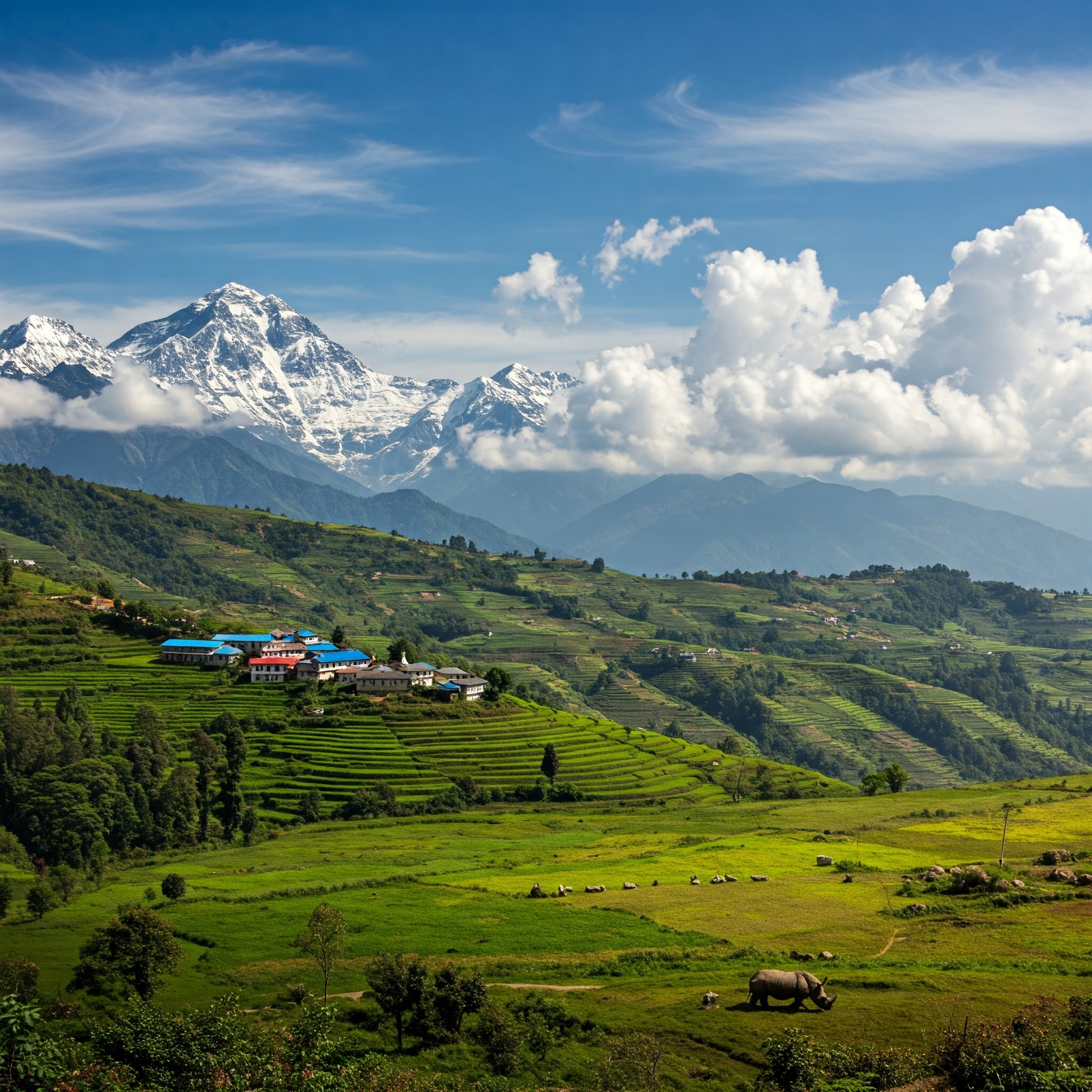From Peaks to Plains: A Guide to Nepal's Diverse Geography and Climate Zones
When one thinks of Nepal, the mind often conjures images of colossal, snow-draped Himalayan peaks. While these majestic mountains are indeed a defining feature, the Geography of Nepal is far more varied and fascinating, stretching from those icy heights down to subtropical plains. This incredible Nepal topography creates distinct regions of Nepal, each with its own unique climate, biodiversity, and way of life. Understanding these diverse landscapes is key to truly appreciating the richness of this Himalayan nation.
The Three Geographic Belts: A Journey Through Nepal's Regions
Nepal can be broadly divided into three parallel ecological belts, running east to west:
The Himalayan Region (Parbat): Where Giants Touch the Sky Dominating the northern part of the country, this region is home to eight of the world's ten highest peaks, including Mount Everest (Sagarmatha). The Himalayan climate is alpine, characterized by extremely cold winters, short cool summers, and significant snowfall. Vegetation is sparse at higher altitudes, consisting of alpine meadows, hardy shrubs, and, eventually, just rock and ice. This challenging environment supports unique fauna like the elusive snow leopard, Himalayan tahr, musk deer, and yaks, which are integral to the local Sherpa and Bhotiya communities' lifestyle. Life here is adapted to the extreme conditions, with livelihoods often revolving around mountaineering, trans-Himalayan trade (historically), and pastoralism. The best season for different regions of Nepal like this for trekking and mountaineering is typically during the spring (March-May) and autumn (September-November) months when the weather is clearer and more stable.
The Hilly Region (Pahad): The Verdant Heartland Sandwiched between the Himalayas and the plains, the Hilly region Nepal is a land of rolling hills, fertile valleys, and majestic Mahabharat and Siwalik mountain ranges. This region experiences a temperate climate in Nepal, with warm summers and cool winters. It's the most ethnically diverse region and supports a significant portion of Nepal's population. The landscape is characterized by intricate terraced farming, where crops like rice, maize, millet, and wheat are cultivated on the hillsides. Lush forests of rhododendron (Nepal's national flower), oak, and pine are common. This region is a vibrant mosaic of cultures and traditions, and the impact of geography on Nepali life is evident in the architecture of its villages perched on hillsides and its agricultural practices adapted to the sloped terrain. Spring and autumn are pleasant here, while winters can be chilly, and summers bring the monsoon rains.
The Terai Region Nepal (Plains): The Fertile Lowlands Stretching along Nepal's southern border with India, the Terai region Nepal is a flat, low-lying extension of the Gangetic Plain. It has a humid, subtropical climate with hot summers, mild winters, and high precipitation during the monsoon season. Historically, much of the Terai was covered in dense forests and grasslands, home to incredible biodiversity, including Royal Bengal tigers, one-horned rhinoceroses, wild elephants, and various deer species. National parks like Chitwan and Bardia are crucial for conserving this wildlife. The Terai is Nepal's agricultural heartland, with fertile alluvial soil supporting extensive cultivation of rice, sugarcane, jute, and other crops. Lifestyles here are adapted to the hotter climate, and the region is a melting pot of cultures. The cooler months from late autumn to early spring (October to March) are generally the best season for different regions of Nepal like the Terai, offering pleasant weather for wildlife safaris and exploration.
A Tapestry of Climates
The climate in Nepal is as diverse as its topography. Beyond the broad alpine, temperate, and subtropical zones, microclimates abound due to variations in altitude and aspect. The country experiences four main seasons:
- Spring (March-May): Warm, with blooming flowers, especially rhododendrons in the hills. Good for trekking.
- Summer/Monsoon (June-August): Hot and wet, with the monsoon bringing heavy rains, especially to the Terai and Hilly regions. Landslides can be an issue.
- Autumn (September-November): Clear skies, pleasant temperatures, and considered the best trekking season. Vibrant festivals like Dashain and Tihar occur.
- Winter (December-February): Cold, especially at higher altitudes with snowfall in the Himalayas. The Terai remains milder.
The Enduring Impact of Geography on Nepali Life
The diverse Nepal topography and varied climate in Nepal have profoundly shaped nearly every aspect of Nepali life:
- Livelihoods: From the mountaineers and yak herders of the Himalayas to the terraced farmers of the hills and the agricultural communities of the Terai.
- Culture and Traditions: Festivals often align with agricultural cycles, and local deities are often associated with natural features like mountains and rivers.
- Housing and Clothing: Building styles and traditional attire vary significantly to suit the local climate and available resources.
- Biodiversity: The range of altitudes and climates has blessed Nepal with an incredible array of flora and fauna, making it a biodiversity hotspot.
- Connectivity and Development: The rugged terrain, particularly in the Hilly and Himalayan regions, poses challenges for infrastructure development and transportation.
Understanding Nepal's Diverse Landscapes
To truly appreciate Nepal, one must look beyond the singular image of snowy peaks. Understanding Nepal's diverse landscapes reveals a country of incredible contrasts and adaptations. Each region, from the icy pinnacles to the steamy plains, contributes to the nation's unique identity, its rich biodiversity, and the resilient spirit of its people. This geographical variety is not just a backdrop but an active force that has shaped Nepal's history, culture, and the daily lives of its inhabitants.
Whether you are trekking to a Himalayan base camp, exploring ancient temples in the vibrant Hilly region, or searching for wildlife in the lush Terai, you are experiencing a facet of Nepal's extraordinary geographical and climatic diversity—a journey from the peaks to the plains that is endlessly captivating.
Please login to leave a comment.


 Rakesh Rajbhat
Rakesh Rajbhat




